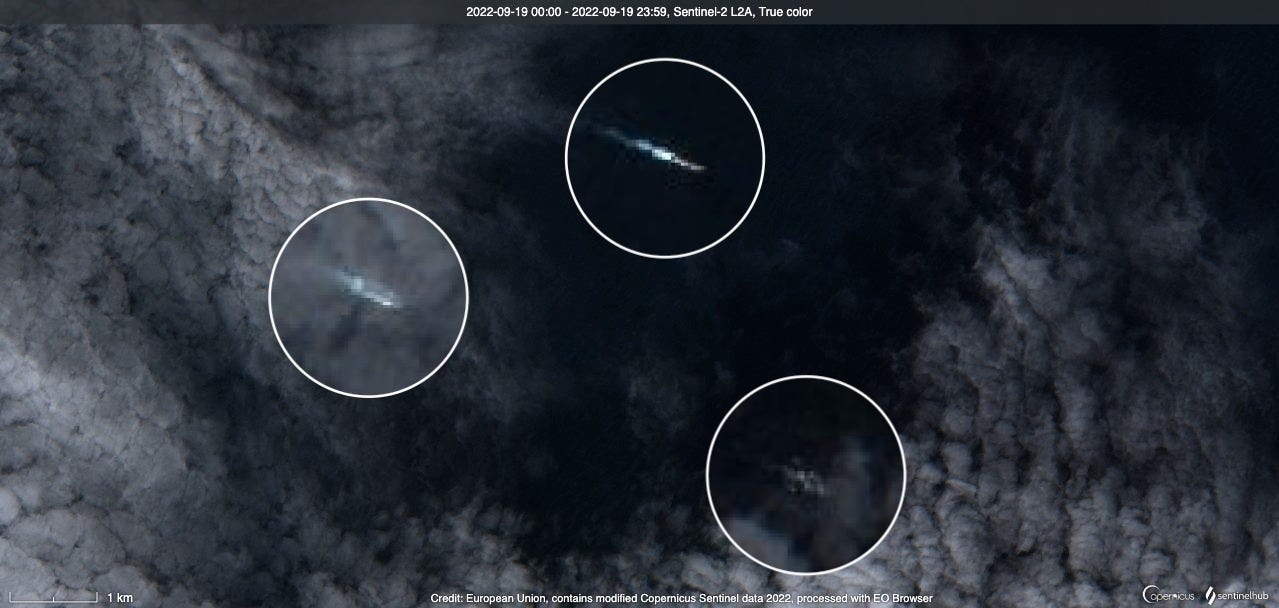Highlights from today’s post:
A naval head-to-head off the coast of a remote Alaskan island
Several of the Japanese Ministry of Defense’s incredibly informative updates on the ships involved
Sentinel-2’s impeccable timing
Digging back into the LOAC archives for my post on a similar incident last year
Plus, OpenCage is back to sponsor another round of Line of Actual Control! In case you’ve joined us in the last few months, OpenCage is a service that converts geo coordinates into useful location information. They operate a highly available, simple to use, worldwide, geocoding API based on open data. Try the API now on the OpenCage demo page.
On September 19, the US Coast Guard Cutter Kimball ran into some unexpected visitors during a routine patrol in the Bering Sea off the coast of Alaska. Her crew spotted three Chinese and four Russian naval vessels sailing in formation 75 miles north of Kiska Island.

But, as luck would have it, the Japanese government had already released plenty of information about the ships involved in the encounter.
They found that several of the Russian ships spent August bopping up and down the Sea of Japan either singly or as parts of a larger Russian surface group.
The Chinese ships were more consolidated, as the three Chinese vessels later spotted in the Bering Sea had been operating as a unit since at least late August. On August 29 and 30, Japanese forces spotted the three ships involved — a Type 054A frigate, a Type 903 replenishment ship, and an enormous Type 101 destroyer — sailing north through the Tsushima Strait between Japan and South Korea.

Sometime between August 30 and September 3, the Chinese ships and three of the four Russian ships rendezvoused in the Sea of Japan. There, they practiced gunnery and posed for some nice photos (below) before heading east into the wide, open Pacific on September 4.

On September 9, the fourth and final Russian ship sailed through Japanese waters into the Pacific and ostensibly joined the rest of the flotilla shortly afterwards. From there, the whole group chugged northeast for a few weeks until the Coast Guard spotted them off Alaska on September 19.
In a stroke of absolutely incredible luck and timing, a Sentinel-2 satellite snapped a shot of three of the eight vessels (three Chinese + four Russian + one American) near Kiska Island that day.

Unfortunately, clouds obscured the other five ships from the satellite’s view that day. I also had no luck with SAR imagery of the area since Sentinel-1B’s untimely demise1 made free SAR images of any given spot on earth fewer and further between. However, the Coast Guard said “the surface action group was temporary in nature, and Kimball observed it disperse”.
By the end of September, the flotilla had returned to Japanese waters via the southern tip of Japan.
From there, the Russian ships broke off to head north again through the Tsushima Straits and then either to the Sea of Japan or to their base at Vladivostok. Meanwhile, the Chinese ships sailed west through the Osumi Strait and then south to return to China.

While we can only speculate what the Russian and Chinese ships were doing up near Alaska, we do know that around the same time last year, a flotilla of Chinese ships traveled to the same region. If you’re interested, you can read about that event here.
It’ll be interesting to see if the pattern repeats next year as well. If so, with the help of Sentinel-2, the Japanese Ministry of Defense, and a good deal of luck, we’ll be able to keep a close eye on the ships involved.








